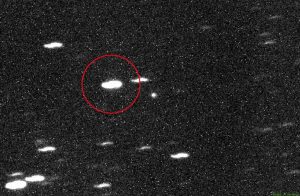This is what NASA does. They launch stuff to smash into asteroids, and I’m here for it. Here’s a video of the final seconds of the DART space probe, before it smashed into the asteroid moonlet Dimorphos (Dimorphos orbits a larger asteroid, Didymos). Wheee!
That video ends abruptly, as you’d expect. The probe launched a separate camera to record the collision, though, and that looks like this:
Why was this collision so strange? In 2022, to develop Earth-saving technology, NASA deliberately crashed the DART spacecraft into the asteroid moonlet Dimorphos. The hope was that this collision would alter the trajectory of Dimorphos around its parent asteroid Didymos and so demonstrate that similar collisions could, in theory, save the Earth from being hit by (other) hazardous asteroids. But analyses of new results show that the effects of the collision are different than expected — and we are trying to understand why. Featured here is the time lapse video taken by the ejected LICIACube camera LUKE showing about 250 seconds of the expanding debris field of Dimorphos after the collision, with un-impacted Didymos passing in the foreground. In 2026, Europe’s Hera mission will reach the asteroids and release three spacecraft to better study the matter.
Very pretty. All those rocks and dust streaming out of the moonlet…
It’s since been acting a bit weird, although more accurately, we ought to say that it acted unpredictably. The moonlet exhibited a slight slow deceleration for a prolonged period.
The DART team has since confirmed that Dimorphos did indeed continue slowing in its orbit up to a month after the impact — however, their calculations show an additional slowdown of 15 seconds, rather than a full minute. A month after the DART collision, the slowdown plateaued.
What caused Dimorphos to slow steadily for a month, before reaching equilibrium? A swarm of space rocks could be to blame: Recent observations of the asteroid have revealed a vast field of boulders — likely shaken loose from Dimorphos’ surface during the impact — strewn about the area. It’s possible that some of the larger boulders fell back onto Dimorphos within that first month, slowing its orbit further than anticipated, DART team member Harrison Agrusa told New Scientist.
I guess we have another reason to think the movie Armageddon was schlock. We can’t calculate the ultimate outcome of space collisions — there are just too many parameters.





